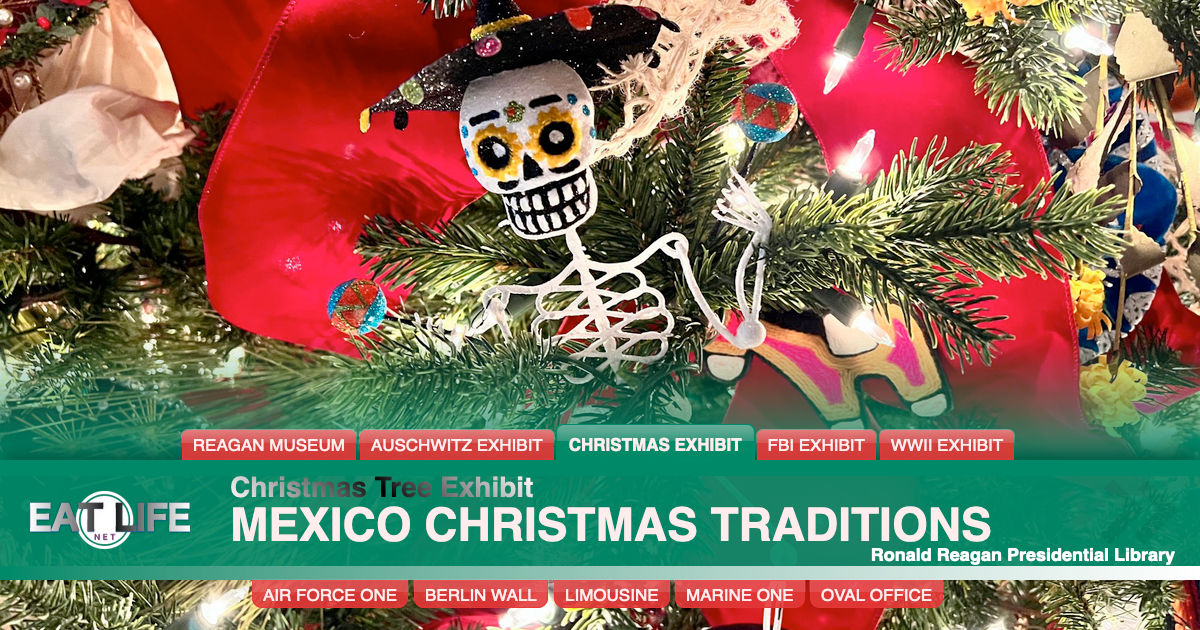MEXICAN CHRISTMAS

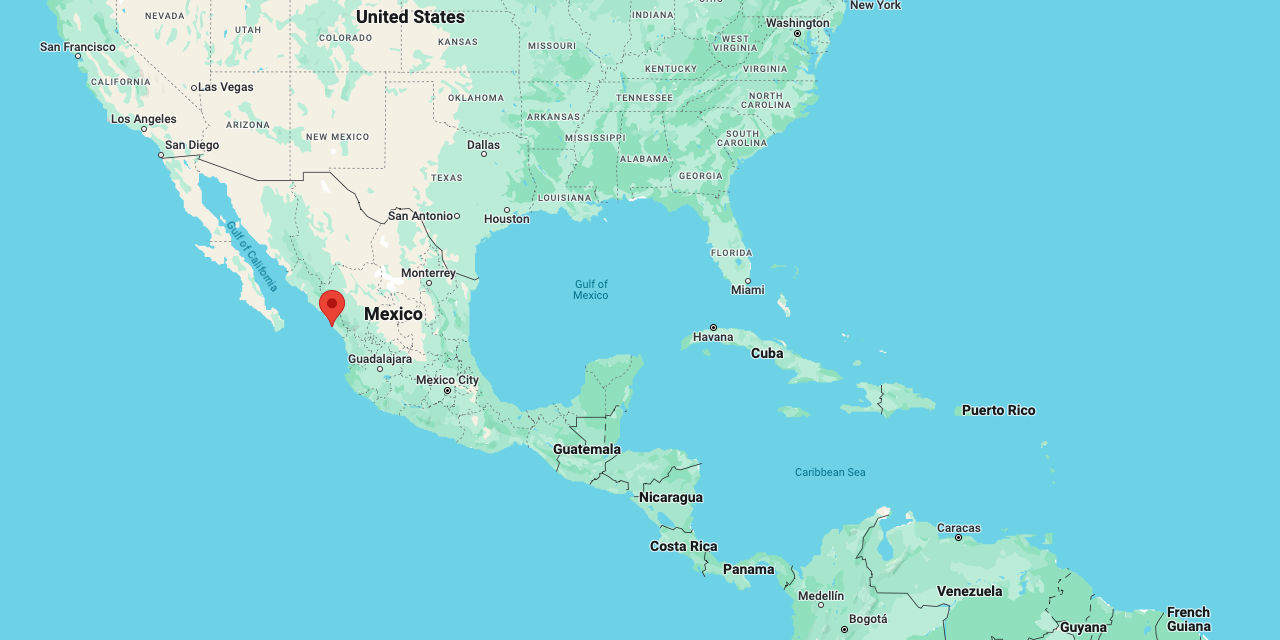
https://www.google.com/maps/place/Mazatlan,+Sinaloa,+Mexico

| HOW TO SAY MERRY CHRISTMAS: | |
|---|---|
| In Spanish | Feliz Navidad |


WHYCHRISTMAS.COMChristmas in Mexico
In Mexico, Christmas is celebrated from December 12th to January 6th.
From December 16th to Christmas Eve, children often perform the 'Posada' processions or Posadas. Posada is Spanish for Inn or Lodging. There are nine Posadas. These celebrate the part of the Christmas story where Joseph and Mary looked for somewhere to stay. For the Posadas, the outside of houses are decorated with evergreens, moss and paper lanterns. Lighting the way for posadas might be 'luminarias' or 'farolitos'. These are paper sacks, with shapes cut into them, which are partly filled with sand and then have a candle put in them. They represent 'lighting the way' for somewhere for Mary and Joseph to stay.In each Posada, children are given candles and a board, with painted clay figures of Mary riding on a donkey and Joseph, to process round the streets with. They call at the houses of friends and neighbors and sing a song at each home. The song they sing is about Joseph and Mary asking for a room in the house. But the children are told that there is no room in the house and that they must go away. Eventually they are told there is room and are welcomed in! When the children go into the house they say prayers of thanks and then they have a party with food, games and fireworks.
Each night a different house holds the Posada party. At the final Posada, on Christmas Eve, a manger and figures of shepherds are put on to the board. When the Posada house has been found, a baby Jesus is put into the manger and then families go to a midnight Church service. After the Church service there are more fireworks to celebrate the start of Christmas.
One game that is often played at Posada parties is pinata. A pinata is a decorated clay or papier-mache jar filled with sweets and hung from the ceiling or tree branch. The pinata is often decorated something like a ball with seven peaks around it. The peaks or spikes represent the 'seven deadly sins'. Pinata's can also be in the form of an animal or bird (such as a donkey). To play the game, children are blind-folded and take it in turns to hit the pinata with a stick until it splits open and the sweets pour out. Then the children rush to pick up as many sweets as they can!
As well as the posada's, there is another type of Christmas play known as Pastorelas (The Shepherds). These tell the story of the shepherds going to find the baby Jesus and are often very funny. The devil tries to stop the shepherds by tempting them along the way. But the shepherds always get there in the end, often with the help of the Archangel Michael, who comes and beats the devil!
- Nativity scenes, known as the 'nacimiento', are very popular in Mexico. They are often very large, with the figures being life size! Sometimes a whole room in a house is used for the nacimiento, although this is less common now. The figures are often made of clay and are traditionally passed down through families. As well as the normal figures of the Mary, Joseph, Jesus, the Shepherds and Three Kings, there are often lots of other figures of different people, including women making tortillas, people selling food and different animals and birds, like flamingos! The figures can be bought from markets in cities all over Mexico. The baby Jesus is normally added to the scene during the evening of Christmas Eve. The Three Kings are added at Epiphany.
- Christmas Trees are becoming more popular in Mexico, but the main/most important decoration is still the nacimiento.
- Christmas Eve is known as 'Noche Buena' and is a family day. People often take part in the final Posada and then in the evening have the main Christmas meal. Popular dishes for the main Christmas meal include Pozole (a thick soup made with hominy, chicken or pork and chilies with is topped with greens), roast turkey, roast pork, tamales, bacalao (salt cod), romeritos (a green vegetable that's cooked in a mole sauce with potatoes and shrimps) and there are normally salads served as side dishes such as Ensalada Nochebuena (Christmas Eve salad). For dessert bunuelos are very popular, they are fried pastries sprinkled with sugar and cinnamon or a hot sugar syrup. Bunuelos come in two shapes flat and round/ball! To drink there might be Ponche (a warm Christmas punch made with fruit) and Rompope (a drink like egg nog which often has rum added to it!).
- At midnight, many people go to a Midnight Mass service, known as the 'Misa de Gallo' (which means Mass of the Rooster as people are up early like Roosters!). There are lots of fireworks to celebrate Christmas Day.
- Poinsettia flowers are known as 'nochebuena' (Christmas Eve) flowers in Mexico.
- On the 23rd December, in the town plaza of Oaxaca City in the Mexican state of Oaxaca, there's 'Noche de Rabanos' (the Night of the Radishes). There are competitions, in different categories, for scenes made up of several carved radishes. The traditional category is for scenes of things like the nativity story, Oaxacan traditions and local wildlife like alligators. The free category has more modern themes like caricatures of politicians. There are different prizes for adults and children.
The radishes used for carving are grown especially for the Noche de Rabanos and they're extra large - often more than 50cm (nearly 20 inches) long and can weigh up to 3kg (6.5lbs). Over 10 tons of radishes are normally used during the festival! The radishes used often have red skin and white flesh, so that when carved, there's a bright difference between the two. They are harvested around the 18th December and carved ready for the 23rd.
The competition of Noche de Rabanos started in 1897. Oaxaca has a tradition of wood carving and farmers began to carve radishes into Christmas figures and table centrepieces to sell at the Christmas market held on the 23rd December.
One legend says the selling and carving of radishes at the Christmas market started in the mid 1700s when two monks brought some extra large radishes to the market. The major of Oaxaca City started the competition in 1897 as a way of attracting more people to the Christmas market.
Thousands of visitors now visit the market every year to see the carved radishes on Noche de Rabanos. The radishes start going brown after a few hours.
- On Christmas Eve churches parade floats through the plaza (these don't have radishes on them!) and on Christmas Day there are fireworks and Christmas meals.
- People in Mexico also celebrate 'los santos inocentes' or 'Day of the Innocent Saints' on December 28th and it's very like April Fools Day in the UK and USA. 28th December is when people remember the babies that were killed on the orders of King Herod when he was trying to kill the baby Jesus.
- In some states in Mexico children expect Santa Claus to come on December 24th. In the south of Mexico children expect presents on January 6th at Epiphany, which is known as 'el Dia de los Reyes'.
- On el Dia de los Reyes the presents are left by the Three Kings (or Magi). If you've had a visit from Santa on Christmas Eve, you might also get some candy on el Dia de los Reyes!
- It's traditional to eat a special cake called 'Rosca de Reyes' (Three Kings Cake) on Epiphany. A figure of Baby Jesus is hidden inside the cake. Whoever has the baby Jesus in their piece of cake is the 'Godparent' of Jesus for that year.
- Another important day, is La Candelaria 'the Candles' or Virgen de la Candelaria 'Virgin of Lights or Candles' (this is also known as Candlemas in other countries around the world) on the 2nd February and it marks the end of the Mexican Christmas celebrations. Lots of Mexicans have a party for Candelaria.
- In Mexico, presents might also be brought by 'El Ninito Dios' (baby Jesus) & Santo Clos (Santa Claus)
Merry Christmas In Mexico most people speak Spanish (Espanol), so Happy/Merry Christmas is Feliz Navidad.
- In the Nahuatl (spoken in some parts of central Mexico) it's Cualli Netlācatilizpan
- In the Yucatec Maya language (spoken in some parts of the Yucatan Peninsula) it's Ki'imak Navidad
The largest ever Angel Ornament was made in Mexico. It was made in January 2001 by Sergio Rodriguez in the town of Zozaya in the state of Nuevo Leon. The angel was 18' 3" high and had wing span of 11' 9"! Perhaps the most amazing thing about the angel was that it was completely made out of old beer bottles, 2946 of them!


1. Let It Snow
You might think Mexico doesn't get any snow during the winter, but that's a big mistake.Mexico is a very large country, and there are not only sunny beaches, but also tall mountain ranges, high valleys, and lush pine forests. That's where we get snow every winter and plenty of it. In fact, at any one time, the snow-covered area of Mexico can be larger than France!
The fun part is, that snowy slopes and fields are never far from any large city. Every winter, families drive out to national parks to play with the snow. It's good, old-fashioned fun!
2. The Endless Days of Christmas
In Mexico, the holiday season begins on December 12th with the feast day of Our Lady of Guadalupe, and Christmas officially starts on December 16th with the first posada, a traditional celebration which features a reenactment of Mary and Joseph's trek to Bethlehem.To have a posada, invite family and friends over, and then split the party in two. Half the people will go outside carrying figures of Mary and Joseph, and the other half will stay inside the house.
Both groups will alternatively sing verses of the the traditional posada song. When the song ends, everyone will go into the house and have tamales, bunuelos, atole, and fruit punch. Also, there might be dancing involved. Repeat every night until Christmas Eve. There's a lot of partying to do in Mexico!
3. 'Tis The Season For Pinatas
The holidays in Mexico are pinata season! At each of the nine mandatory posadas, kids get to break a pinata. Fun, right?However, a traditional holiday pinata has a very deep meaning. How's that?
First of all, a holiday pinata must have a round center with seven spikes, which represent the seven deadly sins. You must cover the eyes of the person hitting the pinata to symbolize blind faith, and the stick represents virtue, which trumps sin. The candy inside represents the gifts that we receive as a reward for our faith in God.
All in all, a pinata is a representation of the triumph of good over evil. And it's also a lot of fun!
4. A Mexican Christmas Pageant
In Mexico, a Christmas pageant is called a pastorela. These are performed at schools, theaters, posadas, and communities all over the country.A traditional pastorela is a little different from a regular pageant. It centers around the shepherds, who must face a series of trials and temptations in order to find their way to Bethlehem to see baby Jesus.
Some pastorelas are dramatic, others are humorous, but the main plot must always center around the shepherds overcoming a struggle with evil and finding their way to Jesus.
Also, the shepherds are always dressed in the traditional attire of Mexican peasants. Charming!
5. A Little Sympathy For The Devil
Strangely, the Devil is an important character in Mexican holidays. We've been talking about how pastorelas and pinatas represent the triumph of good over evil, so it's only logical that the Devil had to be in there somewhere.In pastorelas, the Devil is one of the main characters, always causing mischief for the shepherds. In fact, the Devil is one of the most sought-after roles! Of course, evil never wins, but you have to admit that playing the Devil will give you a big starring role.
Strange as it may seem, devil costumes are in more demand during the holidays than during Halloween. Weird, right?
6. Big Nativity Scenes
Nativity scenes are not exclusive to Mexico, but here they are quite colorful and an important tradition! In fact, I have neighbors who won't set up a Christmas tree, but the nativity scene is a must-have in every home.In some provinces, families will set up the nativity scene out on the front porch or in the front yard. It's fun to walk around the neighborhoods looking at the displays of Mary, Joseph, baby Jesus, and a whole assortment of shepherds, angels, wise men, villagers, and little animals.
Some nativity scenes are huge, spanning villages, forests, farms and waterfalls full of little ceramic figurines set on beds of soft moss. Other nativity scenes feature full-size figures and walk-in mangers. It's quite a show!
7. Mad About Poinsettias
Poinsettias are native to Mexico, and apart from chocolate, I believe they are one of the best gifts my country has ever given the world. These beautiful flowers bloom only during the winter months, which is why they have long been a symbol of Christmas.The Aztecs called them cuetlaxochitl, or "leather-flower", and modern-day Mexicans call them "Christmas Eve flowers". They are found everywhere during the holidays, and everyone loves their radiant color.
Poinsettias were known only in Mexico when the first American ambassador, Joel R. Poinsett, arrived in 1822. He fell in love with the flower and sent samples of it back home to the United States. From then on, the ancient cuetlaxochitl flower gained a new name and worldwide fame.
8. Christmas Eve Fun
In Mexico, Christmas Eve is when the real party happens. Families get together, they have a posada, a delicious Mexican dinner, and open their presents. Everyone stays up at least until midnight to toast the birth of Jesus.On Christmas Day, everyone walks around in their pyjamas, opens the fridge, and takes out last night's leftovers to have a more casual meal, a recalentado. At least that's how we do it. But trust me, there are usually no big parties on Christmas Day in Mexico. Too many people are recovering from a hangover.
9. Greeting The New Year
The New Year has a lot of traditions too. In Veracruz province, the Yucatan peninsula, and all over the southeast, children decorate a tree branch, or La Rama. Then, on New Year's Eve, they walk around town holding up La Rama and singing the traditional New Year's carol, and people give them coins and candy.Families get together again and have dinner on December 31st, and stay up to toast the New Year. At midnight, fireworks explode, church bells toll, and tradition demands that you eat 12 grapes in all, one at each bell toll. Honestly, it's impossible to eat all those grapes without choking, but it's fun to try!
10. Christmas in January
You might think the party is over once January comes around, but it's not. There's still one more day of fun!On the evening of January 5th, children write a letter to the Three Wise Men, or Los Reyes, asking for presents and go to bed early. Meanwhile, every Mexican parent goes out on a crazy shopping spree to get toys for the kids, which lasts until the wee hours. Finally, on the morning of January 6th, children happily wake up to find their presents under the Christmas tree.
There's a lot of Mexican kids who don't believe in Santa Claus, but they all believe in the Three Wise Men. They're every kid's favorite people.



CULTURE TRIPChristmas in Mexico
While countries like the US and the UK celebrate Christmas over perhaps a three-day period at best, from December 24th to 26th, Mexico goes one better – almost one month better actually! Festivities across the country begin on December 12th and extend right through to January 6th the following year. So just how exactly is this holiday period celebrated?Everything gets kicked off with the tradition of posadas. While this literally translates to 'inn', over the yuletide period it refers to a series of processions or parties in which both children and adults participate. Traditionally, each night from December 16th through to Christmas Eve, various houses are decorated and children pass from door to door to sing a song and ask if there's a figurative 'room at the inn'. This recreation of the Christmas tale which sees Mary and Joseph doing much the same thing, only ends on Christmas Eve when they are finally invited in to celebrate and enjoy the party. In practice though, a posada most commonly refers to a generic Christmas party enjoyed in the run up to the festive season, with an abundance of food, drink and, of course, pinatas.
Aside from the posada tradition, Mexico is well-known for its love of an over-the-top Nativity scene, or nacimiento. While many houses will lay out their own interpretation, town centres also go mad for the tradition, with many places creating huge replicas of the manger, surrounded by animals, the Three Kings and shepherds. Baby Jesus, the undeniable main attraction, isn't added until December 24th however.
Speaking of which, in Mexico, unlike the US and the UK, Christmas Eve bears the brunt of the festivities rather than December 25th proper. Otherwise known as nochebuena, Mexicans will typically take part in the final posada celebrations before enjoying a large and extravagant family meal and heading to mass to ring in Christmas Day. It isn't uncommon for there to be fireworks and heaps of poinsettia flowers (a.k.a. flores de nochebuena) present during this time either. As in most of the Western world, the tradition of decorating a Christmas tree has also taken off in Mexico. Again, in town centres right over the festive period, you're likely to come across enormous examples in the central plaza, decked out with lights and decorations to mark the occasion.
An additional Christmas period celebration in Mexico is that of Dia de Los Santos Inocentes on December 28th, not to be confused with Dia de Los Angelitos which takes place on November 1st. The most straightforward explanation for this day of mischief making is that it's the Mexican version of April Fools' Day.
But what about Santa Claus?! Well, he does 'exist' (so to speak) in Mexican Christmas celebrations, although he stops by Mexico on the evening of December 23rd and early hours of December 24th to leave presents. Typically, Mexican children used to expect the delivery of their much longed for gifts on the Dia de Los Reyes (January 6th, otherwise known as Epiphany). They would write a letter to the Reyes Magos, before sending it into the sky tied to a balloon and leaving a shoe on their windowsill in which to receive the presents. While this tradition endures in the south of the country, most other places have adopted a more Western approach to present delivery. Even without presents though, January 6th marks an important date in the Mexican Christmas calendar, as it's when the sweet bread known as Rosca de Reyes is eaten. Hidden within this oval shaped loaf, which is decorated with jellied sweets, are tiny figurines of baby Jesus. But you don't want to be the one to find him in your slice, because tradition dictates that the Jesus-finder must buy everyone tamales on February 2nd during Candelaria, or Candlemas.
While celebrations are generally the same format across the country, there are still some regional traditions worth mentioning, most notably Oaxaca's Noche de Rabanos (Radish Night) which is held annually on December 23rd, and celebrates all things created from radishes. In Yucatan, there's a Mexican take on Christmas caroling over the festive period, whereas the State of Mexico's Tepoztlan, in contrast, is known for its pastorelas, or Nativity plays.

WORLD HOLIDAY TRADITIONSFeliz Navidad
"La Posadas," the remarkable buildup to Christmas Eve, is perhaps the most delightful and unique Mexican tradition. Beginning December 16th, it commemorates the events in the journey of Mary and Joseph from Nazareth to Bethlehem.After dark, each night of the "Posada," a procession begins led by two children. The children carry a small pine-decorated platform bearing replicas of Joseph and Mary riding a burro. Other members of the company, all with lighted long slender candles, sing the "Litany of the Virgin" as they approach the door of the house assigned to the first "Posada." Together they chant an old traditional song and awaken the mast of the house to ask lodging for Mary. Those within the house threaten the company with beatings unless they move on. Again, the company pleads for admittance. When the owner of the house finally learns who his guests are, he jubilantly throws open the doors and bids them welcome. All kneel around the manger scene or "Nacimiento" and offer songs of welcome, Ave Marias and a prayer.
Now it's time of the "Pinata," refreshments and dancing. The "Pinata" is a pottery (or paper) container, brightly decorated and filled with candy and toys. It is hung from he ceiling or a tree. One by one, the children are blindfolded, turned around and instructed to strike the Pinata with a stick. Usually several attempts are made before the container is broken. Of course, when that happens, there is an explosion of goodies and a scattering of children.
On Christmas Eve another verse is added to the Ave Marias, telling the Virgin Mary that the desired night has come. Small children dressed as shepherds stand on either side of the nativity scene while members of the company kneel and sing a litany, after which the Christ Child is lulled to sleep with the cradle song, "El Rorro" (Babe in Arms).
At midnight the birth of Christ is announced with fireworks, ringing bells and blowing whistles. Devout worshipers surge into churches to attend the famous "Misa de Gallo" or "Mass of the Rooster." Following Mass, families return home for a tremendous dinner of traditional Mexican foods. The dishes vary with the different regions. However, somewhat common are the ,"tamales," rice, rellenos, "atole" (a sweet traditional drink) and "menudo," which is said to be more sobering than strong coffee.
Christmas Day has no special celebration though many have adopted the American style Christmas with a Christmas tree and Santa Claus.
Of Special Note...
Mexican children delight in the game where the "Pinata," a pottery or paper container, many times shaped like a bull or donkey, is filled with candy and suspended from the ceiling on a rope. Each child is blindfolded and attempts to break the Pinata with a stick or bat. The child who succeeds is the hero of the festival and the candy is shared by all.

HOW STUFF WORKSChristmas Traditions in Mexico
The weather is warm and mild in Mexico during the Christmas season. Families shop for gifts, ornaments, and good things to eat in the market stalls, called puestos. They decorate their homes with lilies and evergreens. Family members cut intricate designs in brown paper bags to make lanterns called farolitos. They place a candle inside and then set the farolitos along sidewalks, on windowsills, and on rooftops and outdoor walls to illuminate the community with the spirit of Christmas.The Mexican celebration of Christmas is called las posadas and begins on December 16. The ninth evening of las posadas is Buena Noche, Christmas Eve. The children lead a procession to the church and place a figure of the Christ Child in the nacimiento or nativity scene there. Then everyone attends midnight mass.
After mass, the church bells ring out and fireworks light up the skies. Many Mexican children receive gifts from Santa Claus on this night. The children help to set up the family's nacimiento in the best room in the house. The scene includes a little hillside, the stable, and painted clay figures of the Holy Family, shepherds, the Three Kings, and animals. The children bring moss, rocks, and flowers to complete the scene.
Families begin the nine-day observance of las posadas by reenacting the Holy Family's nine-day journey to Bethlehem and their search for shelter in a posada, or inn. In some parts of Mexico, for the first eight evenings of las posadas two costumed children carry small statues of Mary and Joseph as they lead a candlelight procession of friends and neighbors from house to house. They sing a song asking for shelter for the weary travelers. When at last they find a family that will give shelter, the children say a prayer of thanks and place the figures of Mary and Joseph in the family's nacimiento. Then everyone enjoys a feast at the home of one of the participants.
For the children, the pinata party on the first eight evenings is the best part of las posadas. The pinata is a large clay or papier-mache figure shaped like a star, an animal, or some other object and covered with colorful paper streamers. The pinata is filled with candy or small gifts and hung from the ceiling. The blindfolded children are spun around and given a big stick.
They take turns trying to break open the pinata with the stick while the pinata is raised and lowered. Everybody scrambles for the gifts and treats when the pinata shatters and spills its treasure.
Christmas Day is a time for church and family. After church services, Christmas dinner begins with oxtail soup with beans and hot chili, followed by roasted turkey and a special salad of fresh fruits and vegetables.
Many children receive gifts on the eve of Twelfth Night, January 5, from the Reyes Magos, the Three Kings who pass through on their way to Bethlehem. Children leave their shoes on the windowsill and find them filled with gifts the next morning. At a special Twelfth Night supper on January 6, families and friends enjoy hot chocolate flavored with vanilla and cinnamon, and a ring-shaped cake. Whoever gets the slice of cake containing a tiny figure of a baby will give a tamale party on February 2, Candlemas Day.
The whole family helps to prepare the tamales, which are a meat or chicken filling wrapped in corn dough. The tamale is then wrapped in corn husks and steamed. A religious service held on Candlemas marks the end of the Christmas season in Mexico.

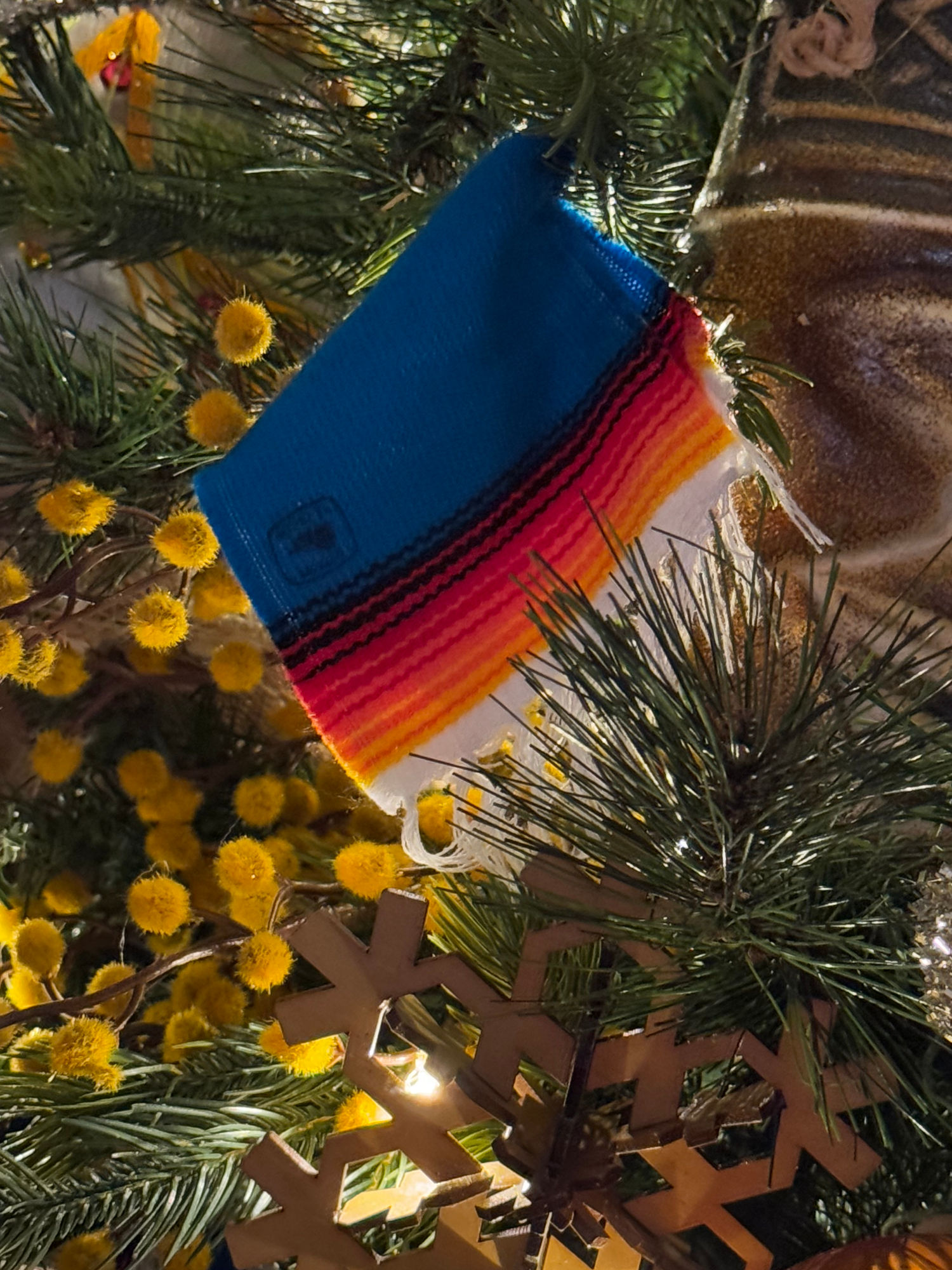

CULTURE TRIPHere's Why Mexican Children Don't Receive Christmas Presents
No, it's not because their parents are mistreating them. While Christmas is definitely an important holiday in Mexico, Three Kings' Day is actually a much bigger holiday and while kids might receive a few gifts on Christmas, the real goodies are saved for the celebration in early January.The holiday that pays homage to the Three Middle Eastern Kings or Magi who brought the baby Jesus gifts 12 days after he was born is celebrated on January 6. There is a common misconception that the 12 days of Christmas ends on December 25. This is incorrect, as the 12 days of Christmas actually last from December 25 to January 6, or the duration of the journey the Three Kings made when they followed the Star of Bethlehem to find baby Jesus.
For Latinos, Three Kings' Day has always been the real kids' holiday as adults don't often participate in gift giving during this celebration like they do at Christmas. Kids leave their shoes outside their doors on the night of the 5th and, just like they do for Santa and his reindeer, they leave a little something for the Kings' camels-some grass and water. The Three Kings, in turn, leave them gifts, large and small, of sweets and toys. This is the day that parents usually reserve for the "big" gifts, like a new bike or a video game.
Kids in Mexico will stay up, just like at Christmas, trying to catch the Three Kings and their camels as they sneak around to hand out their gifts and, of course, no bad little boy or girl will get anything from them. In many parts of Latin America, people will dress up as the Three Kings and parade through town, often in town festivals that are being held with food, dancing and fireworks.
On the day of the Three Kings', families come together and eat a Rosca de Reyes, a type of yeast bread with dried fruit and sugar on top, with some hot chocolate. One or two tiny plastic figurines of the baby Jesus will be hidden in the bread and whoever gets one in their piece of cake must buy the tamales and atole (a hot corn- and masa-based drink) for Dia de la Candelaria, celebrated on February 2 to commemorate when Jesus's parents first took him to the temple to be blessed.
Mexico's proximity to the United States has meant that Christmas traditions have been gaining importance in the Latin American country during the past few years, but Three Kings' Day will always be a special day in Mexico and Mexican kids will continue to wait for it all year long.
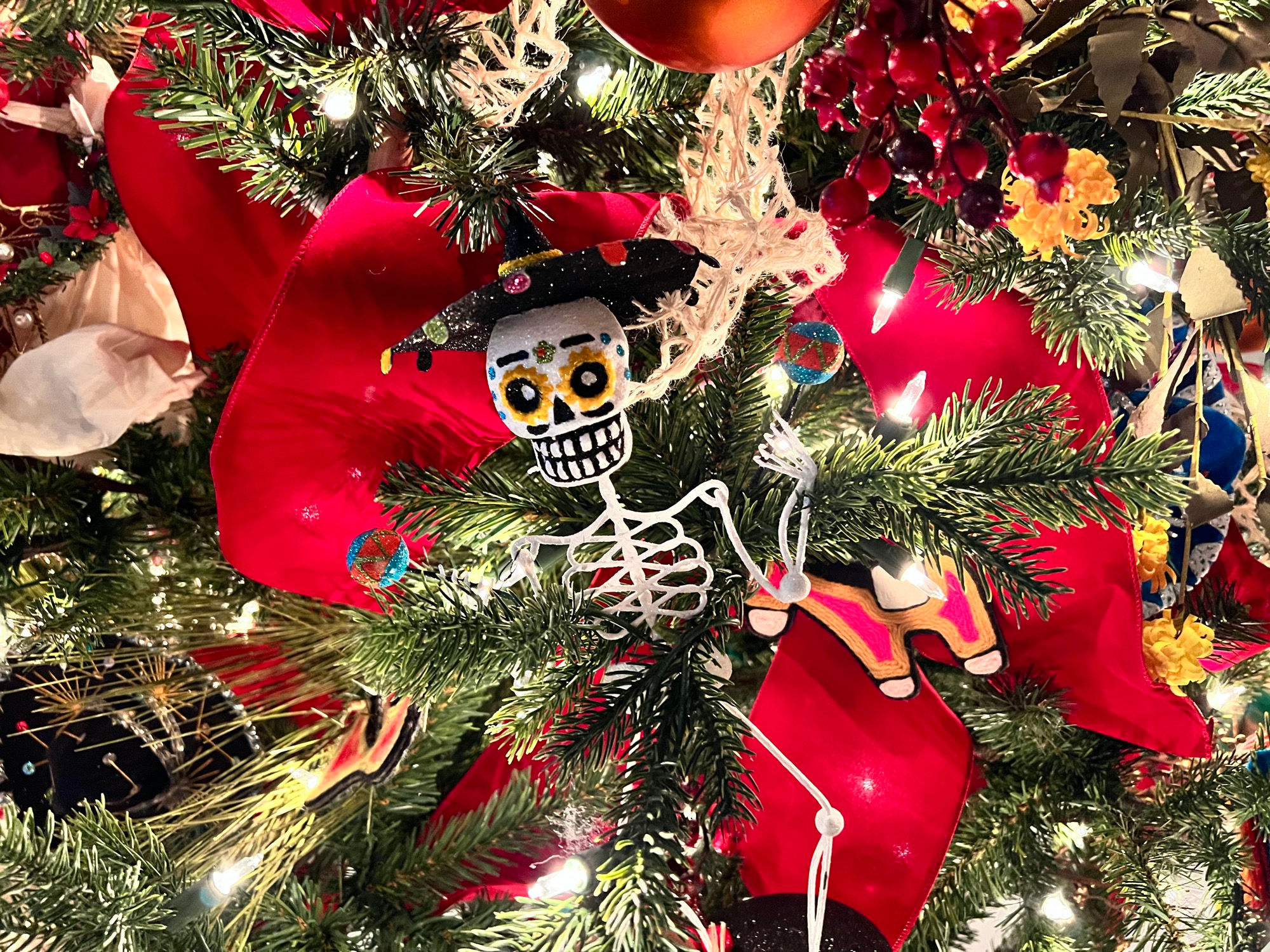
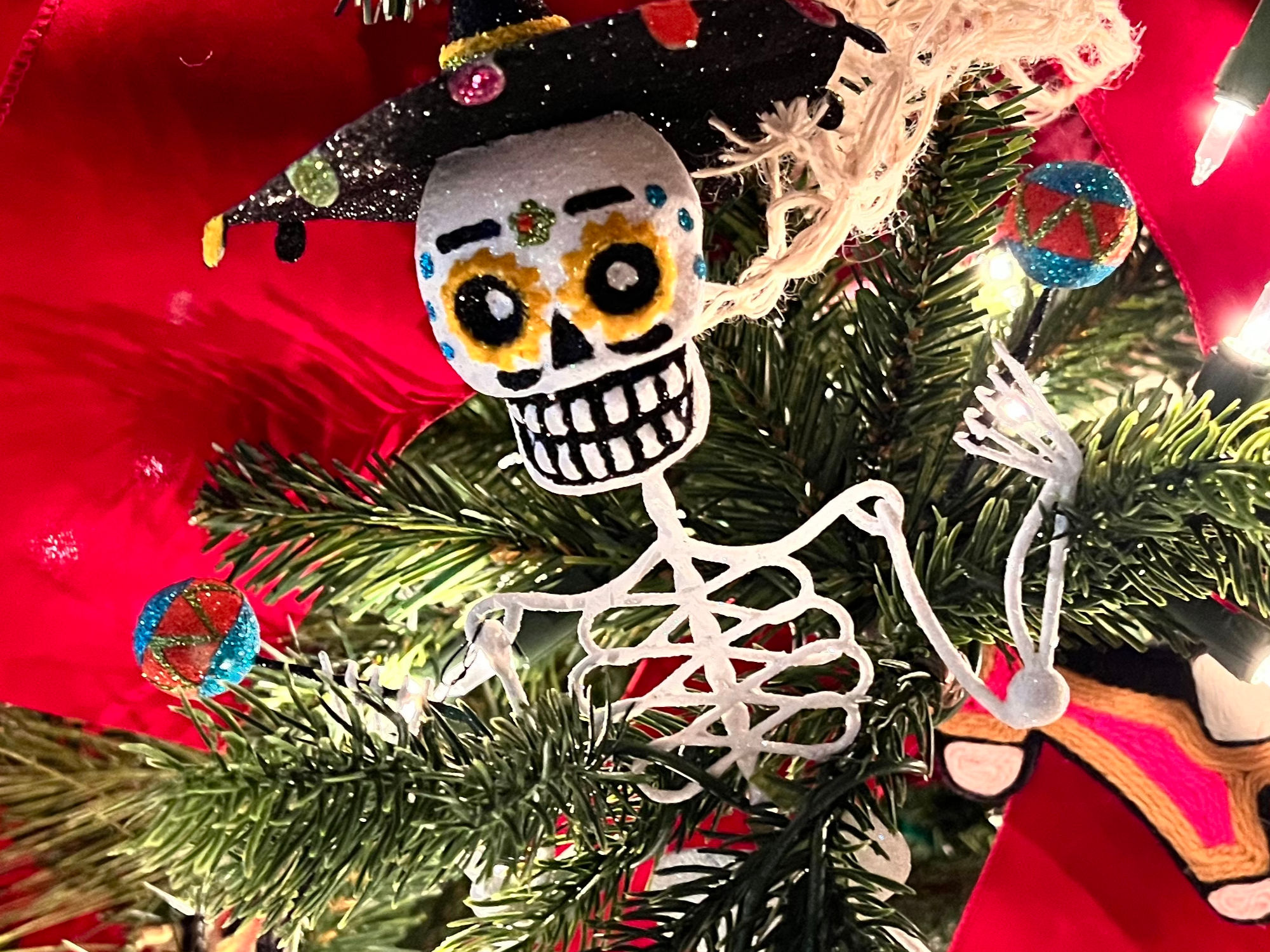
WIKIPEDIAChristmas in Mexico
Christmas in Mexico is observed from December 12 to January 6, with one additional celebration on February 2. Traditional decorations displayed on this holiday include nativity scenes, poinsettias, and Christmas trees. The season begins with celebrations related to the Virgin of Guadalupe, the Patroness of Mexico, followed by traditions such as Las Posadas and Pastorelas.On Christmas Eve, there is a mass and feast. On January 6, the arrival of the Three Wise Men is celebrated with Candlemas and the presentation of images of Jesus as a child at churches. These traditions were formed from influences in both the pre-Hispanic period and Mexico's colonial period, thus incorporating indigenous and Spanish practices. There are also a few influences from both Germany and the United States.


CHEF'S PENCILMexican Christmas Foods
The holiday season in Mexico peaks on Christmas Day, which is celebrated on December 25 and like all national celebrations, traditional food makes its appearance with the prominence it deserves.It's important to remember that before the Colony, in America we didn't have certain foods that are traditional today, such as pork. Also, another not less important fact is that the word Christmas is derived from the Latin nativitas, which means nativity.
Another interesting fact you need to know is that Mexico celebrated its first Christmas in 1526, and Fray Pedro de Gante wrote a letter to King Carlos V describing how it was celebrated with the indigenous people.
Celebration foods in Mexico include mole, pozole, pibil pork, tamales, which are preparations that require great dedication and are almost a ritual.
- Smoked Leg of Pork/Pierna De Puerco Adobada
We start with a dish that makes many Mexicans' mouths water. It is a typical Christmas or New Years' dinner and is usually accompanied by a sweet sauce and garnished with fruit.- Bacalao (Codfish)
Bacalao is a mestizo dish, traditionally served at Christmas dinner, and is of Spanish and indigenous heritage, though later adapted with local ingredients. The Mexican version has olives, capers, gueros chili peppers, oregano, pepper, and tomato.- Rosca de Reyes
This was originally consumed at winter solstice. The oval shape represents the endless love of God, and the doll figure hidden inside the bread symbolizes baby Jesus.- Mexican Apple Salad (Ensalada Navidena)
In northern Mexico, Tarahumara traditions are hearty dinners with local ingredients, such as apple and walnut. This salad is made with apples, sour cream, blueberries or raisins, chopped walnuts, and icing sugar. Garnished with baked coconut and cherries, it's the most traditional Christmas dessert.- Romeritos with Mole
Mullis, or moles, were spicy sauces with many ingredients that little by little became mixed with European foods. Romeritos are prepared with mole and served with rice.- Mexican Christmas Turkey
During the winter solstice, the Aztecs celebrated the so-called Panquetzaliztli, in which the god Huitzilopochtli was celebrated for his triumph over the goddess of the moon, Coyolxauhqui. At this festival, the main dish was guajolote, wild turkey. It's usually filled, injected, or bathed with white wine, butter, and spices.- Arroz Verde (Green Christmas Rice)
It's not just any rice, this rice is made with poblano pepper and is very common at Christmas dinner.- Marshmallow Salad (Ambrosia Salad)
This is a delicious and easy to prepare dessert. It's made with gelatin cut into squares, with nuts, condensed milk, marshmallows, and fruit, such as peeled orange wedges.- Shrimp Tortitas/ Tortillitas o tortitas de camarones
These are breaded fried shrimp balls, or tortillas, and are one of the star Christmas dishes. They're made with dried shrimp and are the perfect accompaniment for Romeritos.- Tamales
Tamales were made to offer to deities. Early Mexican culture had a lunar calendar with 18 months, each of 20 days. Later, for Christmas, they added lard to make them a Christian dish.- Bunuelos: Fritters
During the Christmas season, you can see a lot of bunuelos. They're made with honey, brown sugar, and cinnamon and are fried and sprinkled with sugar.- Champurrado
This drink, that accompanies tamales or desserts, is made with corn, chocolate, water, brown sugar, and vanilla. All the ingredients are brought to a boil and cooked until it thickens. Originating with the Aztecs, it's now the most famous Christmas drink across the entire country.- Pozole
There are several styles of pozole depending on the region. It is one of the most famous dishes of Mexico and is made with corn kernels, pork or chicken, spices, and six different dry chilies.- Birria
Birria stew is originally prepared with goat or lamb meat. However, there are places where they also make it with veal, beef, pork, or a mix of meats. The meat is marinated with ground chili peppers for several hours, then wrapped in maguey leaves, and cooked in an underground oven.- Menudo (Mexican Tripe Soup)
This is a spicy soup made with corn kernels, or without them, pork feet, and beef stomach as the main ingredients. It is an ethnic dish that is also called pancita.- Castilla Pumpkin Candy
In Chiapas, they honor the Virgin's nine months of pregnancy by eating pumpkin candy in front of the church's atrium, on the morning of December 26. The Castilla Pumpkin is confit, from which pumpkin concentrate is obtained.- Guacabaqui
A stew of beans with beef or pork on the bone that the Yaqui Indians consider a ceremonial dish. In some recipes, they put vegetables or chickpeas.- Stuffed Chili (Chiles Rellenos de Picadillo)
Stuffed chili is prepared with poblano peppers that are roasted and stuffed with cheese or meat, then coated with an egg and flour mixture, and finally fried.- Mixiote
Mixiote is a dish from pre-Hispanic times. It can be filled with beef, chicken, fish, mutton, pork, or shrimp. The preparation is somewhat tedious and requires a lot of patience, but it's worth a try.- Stuffed Cheese (Queso Relleno Yucateco)
This is certainly a very delicious dish. The cheese with which it's prepared, known as queso de bola, is a Dutch cheese. It is filled with spicy ground pork and vegetables, bathed in a delicious sauce, and garnished with green olives.


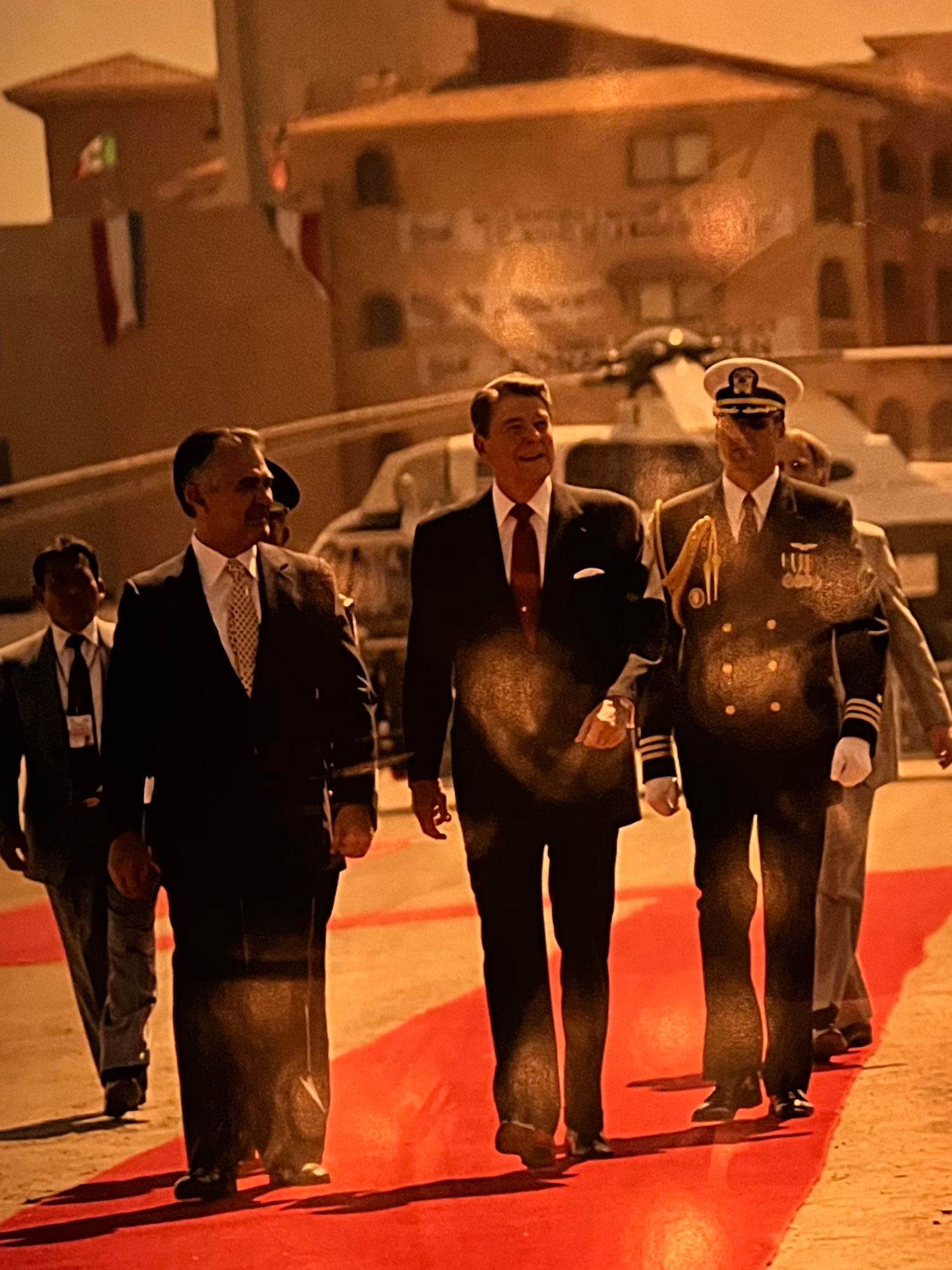
President Reagan reviewing troops during an arrival ceremony for meeting with President de la Madrid of Mexico in Mazatlan with J.J. Quinn.
Reagan's Daily DiarySaturday, February 13, 1988
Up early in morning & breakfast on the plane. Flew down to Mazatlan for summit with Pres. de la Madrid. We’re both in our last year in office. He & I met 1st with only note takers & interpreters. They were good meetings on our mutual drug problem, on trade & on the threatened increase of Soviets in Mexico. He’s aware of that threat & refused to allow Soviets to set up consulates along our border.The plenary meeting was over lunch & again a good cordial exchange of views on ec. issues etc. Then the farewell ceremony and it was off to El Rancho del Cielo. Nancy was already at the ranch. Something happened to the pump in our well-no water in the houses at all. We made do with bottled water for everything.
Key Facts
- President Reagan travels to at resort in Mazatlan, Mexico.
- President Reagan and Mexican President Miguel de la Madrid meet and discuss drug trafficking, Soviet influence in Mexico, and trade.
RONALD REAGANRemarks at the Welcoming Ceremony for President Reagan in Mazatlan, MexicoFebruary 13, 1988
President De la Madrid. Your Excellency Ronald Reagan, President of the United States of America, members of his party, ladies and gentlemen: On behalf of the people and the Government of Mexico, I am very pleased to extend a most cordial welcome to the President of the United States of America and to the distinguished members of his party.
This is the sixth time that we two Presidents have met and, on balance, this type of top-level communication between the governments of our countries has shown itself to be both effective and useful. On the basis of personal friendship and direct, frank communication, we two Presidents have periodically had the opportunity to review issues of interest to us and to improve the manner in which our relations are conducted.
I must gratefully acknowledge President Reagan's interest in maintaining our relations within an atmosphere of mutual cordiality, dignity, and respect. We have dealt successfully with delicate issues and broadened the basis for cooperation, which, as neighbors, our two countries require. Today we can affirm that our relations are conducted on a very positive level. There is fluid and wide-ranging communication between the two governments, and we have institutional mechanisms, not only to solve but also to prevent problems.
I am certain, Mr. President, that on this occasion, perhaps the last time we meet as Presidents, we will strengthen the basis for good and productive relations and discuss as frankly as we always have the problems on our agenda. President Reagan, I cordially welcome you and also the members of your party.
President Reagan. President De la Madrid, distinguished guests, people of Mexico: This is a momentous occasion for me. Over 5 years ago, President De la Madrid and I first met near the border in Tijuana. We dedicated ourselves to building on the strength, friendship, and cooperation that are traditional bonds between our two countries. We resolved to address the daily concerns of our citizens with mutual respect and understanding. We set out to make progress on difficult issues and to discuss areas of disagreement with the candor of good friends. The personal rapport we developed has served the interests of both our peoples.
Today Mexico and the United States stand together as we strive to meet the perplexing challenges that face our nations. We can be proud of what has been accomplished in so short a period. We have created dynamic commercial ties that lay the foundation for a stronger and expanding trade relationship and more competitive economies. We have worked together to find positive and creative solutions to a threatening international debt problem. We have established strong new mechanisms to deal with border matters. We have strengthened law enforcement cooperation, reducing the ability of criminals to take advantage of different jurisdictions.
Today we will meet again in the spirit of good will and cooperation that has been the hallmark of our relations. Today we help pave the way for a new generation of political leaders in both our countries who will soon follow us and build on the foundation we've laid. That foundation is cemented by our shared values and common goals: a better quality of life for our peoples, opportunities for our children, and the dignity of living peacefully in free and democratic societies. Much still needs to be done to achieve these goals, but we can be proud of the legacy we leave.
Mr. President, next year we will commemorate the 100th anniversary of the founding of the U.S.-Mexico International Boundary and Water Commission. The Commission has been a success, a model for others throughout the world. It is concrete and living proof that two nations can live as neighbors, deal with the reality of a 3,000-kilometer border, and respect each other's sovereign independence and identity.
There will be no greater monument to this upcoming anniversary, which marks a century of Mexican-American cooperation, than the current high plane of relations between the leaders of our countries and the bonds of family, commerce, and friendship between our peoples. This is the spirit in which I come today. Thank you, and God bless you.
NOTEThe President spoke at 12:17 p.m. at the Camino Real Hotel, where he was accorded a formal welcome with full military honors. The Presidents' remarks were translated by interpreters. Following the ceremony, they met with U.S. and Mexican officials at the hotel.
WIKIPEDIAThe United Mexican States
A country in the southern portion of North America. It is bordered to the north by the United States; to the south and west by the Pacific Ocean; to the southeast by Guatemala, Belize, and the Caribbean Sea; and to the east by the Gulf of Mexico. Mexico covers 761,610 sq miles, making it the world's 13th-largest country by area; with a population of almost 130 million, it is the 10th-most-populous country and has the most Spanish speakers. Mexico is organized as a federal republic comprising 31 states and Mexico City, its capital.Human presence in Pre-Columbian Mexico goes back to 8,000 BCE. It became one of the world's six cradles of civilization. The Mesoamerican region was home to many intertwined civilizations, including the Olmec, Maya, Zapotec, Teotihuacan, and Purepecha. The Aztecs dominated the region in the century before European contact. In 1521, the Spanish Empire and its indigenous allies conquered the Aztec Empire from its capital Tenochtitlan (now Mexico City), establishing the colony of New Spain. Over the next three centuries, Spain and the Catholic Church expanded the territory, enforced Christianity and spread the Spanish language. With the discovery of rich deposits of silver in Zacatecas and Guanajuato, New Spain became one of the most important mining centers worldwide. The colonial order came to an end in the early nineteenth century with the Mexican War of Independence.
Mexico's early history as an independent nation state was marked by political and socioeconomic upheaval, both domestically and in foreign affairs. The United States invaded as a consequence of the Texas Revolt by American settlers, which led to the Mexican–American War and huge territorial losses in 1848. After the introduction of liberal reforms in the Constitution of 1857, conservatives reacted with the War of Reform and prompted France to invade the country and install an Empire, against the Republican resistance led by liberal President Benito Juarez, which emerged victorious. The last decades of the 19th century were dominated by the dictatorship of Porfirio Diaz, who sought to modernize Mexico and restore order. However, the Porfiriato era led to great social unrest and ended with the outbreak in 1910 of the decade-long Mexican Revolution (civil war). This conflict led to profound changes, including the proclamation of the 1917 Constitution, which remains in effect to this day. The remaining war generals ruled as a succession of presidents until the Institutional Revolutionary Party (PRI) emerged in 1929.
The PRI governed Mexico for the next 70 years, first under a set of paternalistic developmental policies of considerable economic success. During World War II Mexico also played an important role for the Allied war effort. Nonetheless, the PRI regime resorted to repression and electoral fraud to maintain power, and moved the country to a more US-aligned neoliberal economic policy during the late 20th century. This culminated with the signing of the North American Free Trade Agreement in 1994, which caused a major indigenous rebellion in the state of Chiapas. PRI lost the presidency for the first time in 2000, against the conservative party (PAN).
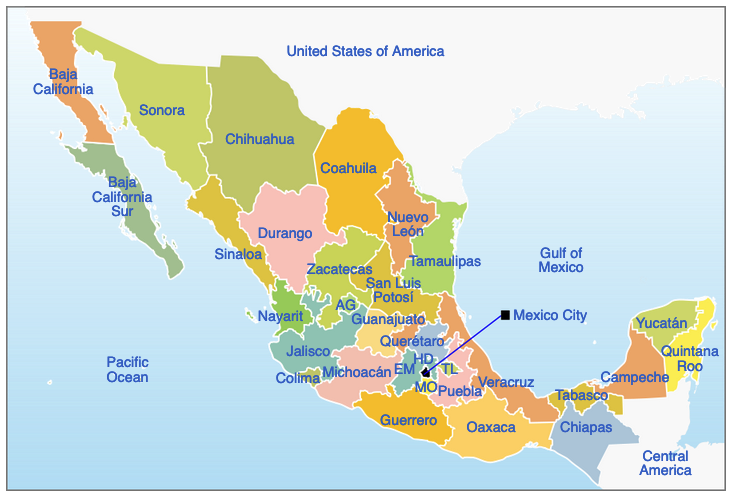
- Mexico has 31 states and the Capital Mexico City. Mexico City is a special political division that belongs to the federation as a whole and not to a particular state. The states are divided into municipalities, the smallest administrative political entity in the country, governed by a mayor or municipal president (presidente municipal), elected by its residents by plurality.
- Mexico has the world's 15th-largest economy by nominal GDP and the 11th-largest by PPP, with the United States being its largest economic partner.
- As a newly industrialized and developing country ranking 86th, high in the Human Development Index, its large economy and population, cultural influence, and steady democratization make Mexico a regional and middle power which is also identified as an emerging power by several analysts.
- Mexico ranks first in the Americas and seventh in the world for the number of UNESCO World Heritage Sites.
- It is also one of the world's 17 megadiverse countries, ranking fifth in natural biodiversity.
- Mexico's rich cultural and biological heritage, as well as varied climate and geography, makes it a major tourist destination: as of 2018, it was the sixth most-visited country in the world, with 39 million international arrivals.
- The country continues to struggle with social inequality, poverty and extensive crime. It ranks poorly on the Global Peace Index, due in large part to ongoing conflict between drug trafficking syndicates. This "drug war" has led to over 120,000 deaths since 2006.
- Mexico is a member of United Nations, the G20, the Organization for Economic Co-operation and Development (OECD), the World Trade Organization (WTO), the Asia-Pacific Economic Cooperation forum, the Organization of American States, Community of Latin American and Caribbean States, and the Organization of Ibero-American States.
- The earliest human artifacts in Mexico are chips of stone tools found near campfire remains in the Valley of Mexico and radiocarbon-dated to circa 10,000 years ago. Mexico is the site of the domestication of maize, tomato, and beans, which produced an agricultural surplus. This enabled the transition from paleo-Indian hunter-gatherers to sedentary agricultural villages beginning around 5000 BCE.
- Mexico's total area is 761,606 sq miles, making it the world's 13th largest country by total area. The climate of Mexico is quite varied due to the country's size and topography.
- With over 200,000 different species, Mexico is home of 10–12% of the world's biodiversity. Mexico ranks first in biodiversity in reptiles with 707 known species, second in mammals with 438 species, fourth in amphibians with 290 species, and fourth in flora, with 26,000 different species. Mexico is also considered the second country in the world in ecosystems and fourth in overall species. About 2,500 species are protected by Mexican legislation.
- Mexico has the 15th largest nominal GDP (US $1.15 trillion) and the 11th largest by purchasing power parity (US $2.45 trillion) (2018). Agriculture has comprised 4% of the economy over the last two decades, while industry contributes 33% (mostly automotive, oil, and electronics) and services (notably financial services and tourism) contribute 63%. Mexico is now firmly established as an upper middle-income country.
- The electronics industry of Mexico has grown enormously within the last decade. Mexico has the sixth largest electronics industry in the world after China, the United States, Japan, South Korea, and Taiwan.
- Mexico produces the most automobiles of any North American nation. The industry produces technologically complex components and engages in some research and development activities. The "Big Three" (General Motors, Ford and Chrysler) have been operating in Mexico since the 1930s, while Volkswagen and Nissan built their plants in the 1960s.
- As of 2017, Mexico was the 6th most visited country in the world and had the 15th highest income from tourism in the world which is also the highest in Latin America. The coastlines of Mexico are rich in sunny beach stretches. On the Yucatan peninsula, one of the most popular beach destinations is the resort town of Cancun, especially among university students during spring break. To the south of Cancun is the coastal strip called Riviera Maya which includes the beach town of Playa del Carmen and the ecological parks of Xcaret and Xel-Ha. To the south of Cancun is the town of Tulum, notable for its ruins of Maya civilization. Other notable tourist destination include Acapulco with crowded beaches and multi-story hotels on the shores. At the southern tip of the Baja California peninsula is the resort town of Cabo San Lucas, noted for its marlin fishing. Closer to the United States border is the weekend draw of San Felipe, Baja California.
- In Mexican cities along the Mexico–United States border the most lucrative hospitality industry is now medical tourism, with remnants of the traditional motivations that drove tourists to Mexico's northern borderlands for nearly a century. Dominant medical tourism for the purpose of tourism planning are the purchase of medication, dentistry, elective surgery, optometry, and chiropractic.
- Spanish is the de facto national language spoken by the vast majority of the population, making Mexico the world's most populous Hispanophone country. Mexican Spanish refers to the varieties of the language spoken in the country, which differ from one region to another in sound, structure, and vocabulary.
- Roman Catholicism remains the country's dominant religious affiliation.
- The origin of the current Mexican cuisine was established during the Spanish colonial era, a mixture of the foods of Spain with native indigenous ingredients. Foods indigenous to Mexico include corn, pepper vegetables, calabazas, avocados, sweet potato, turkey, many beans, and other fruits and spices. Similarly, some cooking techniques used today are inherited from pre-Columbian peoples, such as the nixtamalization of corn, the cooking of food in ovens at ground level, grinding in molcajete and metate. With the Spaniards came the pork, beef and chicken meats; peppercorn, sugar, milk and all its derivatives, wheat and rice, citrus fruits and another constellation of ingredients that are part of the daily diet of Mexicans.
- Traditional Mexican music includes mariachi, banda, norteno, ranchera, and corridos.
- Organized sport in Mexico largely dates from the late nineteenth century, with only bullfighting having a long history dating to the early colonial era. Mexico's most popular sport is association football. Other sporting activities include Baseball, Olympics, Bullfighting, boxing, and Lucha Libre (freestyle professional wrestling). Bullfighting (Spanish: corrida de toros) came to Mexico 500 years ago with the arrival of the Spanish. Despite efforts by animal rights activists to outlaw it, bullfighting remains a popular sport in the country, and almost all large cities have bullrings. Plaza Mexico in Mexico City, which seats 45,000 people, is the largest bullring in the world. Mexico is an international power in professional boxing. Thirteen Olympic boxing medals have been won by Mexico.
EtymologyMēxihco is the Nahuatl term for the heartland of the Aztec Empire, namely the Valley of Mexico and surrounding territories, with its people being known as the Mexica. It is generally believed that the toponym for the valley was the origin of the primary ethnonym for the Aztec Triple Alliance, but it may have been the other way around.














